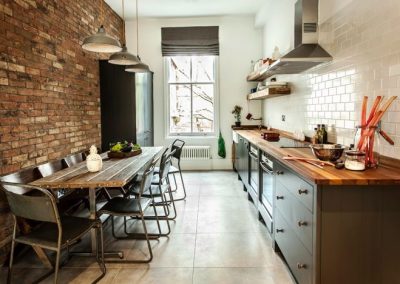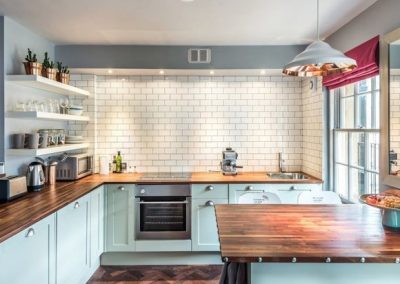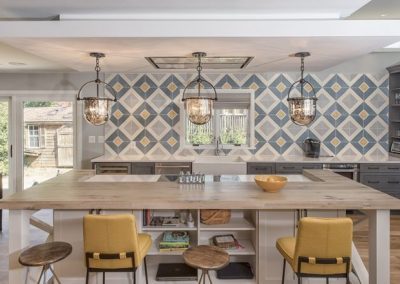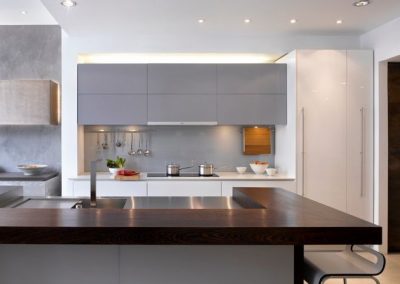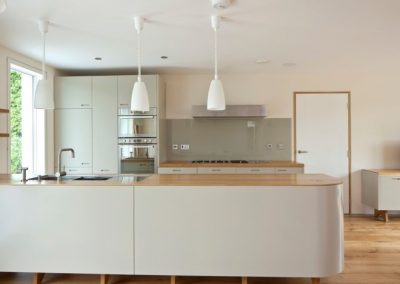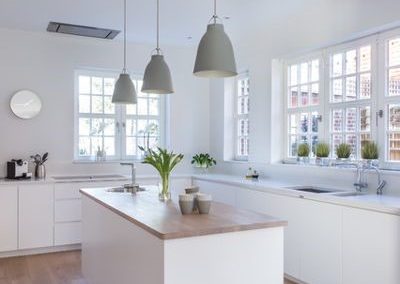Another in my series of ‘Ask the Experts’: Below is an article from Houzz which provides a very detail explanation of the different types of Wooden Worktops available in today’s market.
Wood provides a warming element to any decor, with its natural hues and ability to match any colour scheme, making it a popular choice for kitchen worktops. What’s more, thanks to the different stains, grains and tones, as well as the options on thickness, shape and edging finishes, your wooden worktop will be unique. Get inspired by this tantalising selection of timber tops.
Oak: for a traditional vibe
Probably the classic choice for a farmhouse-style kitchen with Shaker-style cabinetry, oak is a mid-brown hardwood with an attractive grain. As it’s so readily available, it’s also one of the least expensive wooden work surfaces.
As with all wooden tops, you’ll need to treat it with oil. Recommendations differ between suppliers, but some suggest daily applications for the first week, reducing it to once a week, then every few months thereafter. If you treat your timber well at the outset, it should give you many years of reliable service.
If you want the beauty of oak grain but with a paler tone, consider using a white stain. It’s perfect for minimalist and simple designs, and it doesn’t contrast dramatically with all-white cabinetry.
Oak can also be stained darker, if you prefer, to create a similar look to more expensive dark woods such as walnut or wenge.
The most common thickness for a wooden worktop is 40mm, but it’s possible to commission a super-slim top to provide the ultimate in subtle surfaces, as seen here. This wafer-thin oak sliver follows the cabinet curve for a neat finish.
Alternatively, go for a chunkier slab, with a thickness of up to 100mm, for a bold statement piece on an island or bar.
Wenge: for dramatic dark tones
If it’s contrast you’re after, wenge is a distinctive wood in a dazzling dark shade. It’s very dense, so it’ll work hard for you in the kitchen. All wood worktops get gradually darker over time as they’re exposed to the light and air, so you should see this material’s rich grains becoming ever more beautiful.
Walnut: for gorgeous contrast
Darker than oak, but not as intensely toned as wenge, walnut occupies a slightly more cosy middle ground among the darker woods. It sits beautifully against creams and whites, creating a warm contrast between units and worktop.
Depending on your budget, it’s possible to get walnut worktops (and other woods, too) in a variety of styles. The least expensive is the butcher’s block, which combines blocks of wood in a brick pattern. This is very strong (hence the name: butchers would use them as chopping boards, so they had to be durable), but you don’t get to see the grain that would be visible in a larger plank. At the other end of the scale is the full stave or plank, which shows off the walnut in all its grainy glory.
Birch, beech or maple: to lighten things up
Lighter shades of wood with reddish or yellow tones have always been a popular choice for worktops. Some people like to match their work surface to their flooring for a unified scheme.
The advantage of a lighter-shade wood is that it tends not to dominate: in this kitchen, the pale grey birch tops aren’t fighting for attention with the vibrant tiled feature wall.
As mentioned, most suppliers recommend oiling your wood to create a watertight finish, but there are other options. One of these is applying wax, as seen here. Wax is thicker than oil and gives a matt texture to this maple wood.
If you decide to go with this look, you’ll need to polish it regularly to retain a shine, so be aware of this extra workload. Wax is also used to ‘mend’ cracks or splits in tired or damaged work surfaces. Fill the gaps with colour-matched wax, re-sand and then oil it back to health.
Reclaimed teak: for toughness
Teak is well known for making an extremely tough and durable work surface that repels water. Most school science labs had teak tops on the desks to cope with any number of failed experiments, so it can be assumed that one slip with a hot pan is not going to prove fatal.
However, teak’s eco credentials are less than ideal, and most timber from this slow-growing tree (which can’t be replaced quickly and is thus endangered), is actually illegal to import. If you’re planning to use this wood in your kitchen, make absolutely sure it comes from a sustainable, verified source. Even then, you may be better off searching for reclaimed pieces, like the gorgeous slabs in this kitchen; after all, there’s no more respectful way to treat our trees than to use them more than once.
Iroko: for reliability
Iroko is sometimes seen as a more sustainable and readily available alternative to teak. It’s also a very dense hardwood, so it’s more water-resistant than other, softer timbers.
Whether using iroko is ecologically sound is the subject of some debate; often, its exact provenance is hard to trace and there’s evidence to suggest that illegal iroko logging is destroying some wildlife habitats. As with all woods, check for FSC accreditation to ascertain exactly where it comes from and that these forests are sustainable.
Recycled scaffold planks: to boost eco points
Repurposing existing timber is a reliably green approach, and with a growing market in vintage goods and reclamation yards, recycled timber is now easily available. Scaffolding planks will have existing scratches and quirks, so they’re not the right choice for everyone, but after a good sand and oil, they’ll ooze with rustic charm and bring plenty of character to any kitchen.
Bamboo: to keep things fresh
If you’re set on a new, rather than reclaimed worktop, your best eco-bet is super-fast-growing (and therefore easily replaceable) bamboo. It’s actually a grass and not a wood, but it has a very woody appearance and many comparable attributes.
Made from separate ‘staves’, which are pieced together, the wood is incredibly hard and dense, making it perfect for a kitchen. Bamboo worktops tend to be light in colour have a pretty pattern at the ends, showing how the separate layers run.
While it’s pretty durable and tough, it may prove harder to get rid of stains on a bamboo surface – burn marks or stains on wood are normally removed by lightly sanding and re-oiling, but because these worktops are constructed from lots of little layers, sanding isn’t always possible without compromising the structure.
Plywood: for back-to-basics practicality
Adventurous designers are increasingly using plywood as a finished and visible product, as opposed to a hidden structural material. Some kitchens feature plywood doors, but it’s also possible to use ply on your work surfaces.
Ply can be manufactured out of many different sorts of wood, with birch being one of the most popular. Marine ply will probably contain hardwoods (again, check for certification: your supplier should be able to provide you with a source), and will deal well with high-humidity areas.
One super-economical approach is to sand down and varnish plywood. Alternatively, top it with a laminate layer, Formica or even a sheet of metal, as done here. This will give a smooth working surface and leave an attractive wood grain pattern visible along the edges.


